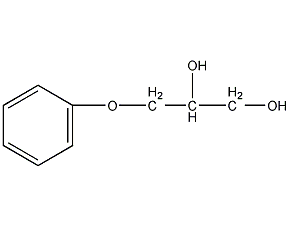
Structural formula
| Business number | 05J9 |
|---|---|
| Molecular formula | C9H12O3 |
| Molecular weight | 168.19 |
| label |
Glycerol alpha-Monophenyl Ether, 3-Phenoxy-2-propanediol, alpha-Phenylmonoglycerylether, 1-Fenoxy-2,3-propandiol |
Numbering system
CAS number:538-43-2
MDL number:MFCD00004717
EINECS number:208-692-8
RTECS number:TZ1050000
BRN number:None
PubChem ID:None
Physical property data
1. Character: white crystal
2. Density (g/mL,25/4℃): Undetermined
3. Relative vapor density (g/mL,AIR=1): Undetermined
4. Melting point (ºC): 50 -52
5. Boiling point (ºC,Normal pressure):315
6. Boiling point (ºC,5.2kPa): Undetermined
7. Refractive index: Undetermined
8. Flashpoint (ºC): 315
9. Specific optical rotation (º): Undetermined
10. Autoignition point or ignition temperature (ºC): Undetermined
11. Vapor pressure (kPa,25ºC): Undetermined
12. Saturated vapor pressure (kPa,60ºC, peripheral nerves and sensation – flaccid paralysis without anesthesia (usually neuromuscular blockade), altered sleep duration (including altered righting reflex), respiratory depression;
Mouse transperitonealLD50: 1240 mg/kg, peripheral nerves and sensation – Flaccid paralysis without anesthesia (usually nerve muscle block), –muscle weakness and changes in the lungs, chest, or breathing;
Mouse subcutaneouslyLD50: 920mg/kg, autonomic nervous system – smooth muscle relaxation (mechanism undefined, antispasmodic) ;
Unknown mammals by mouthLD50:>5gm/kg, except No details other than lethal dose;
Ecological data
The substance May be harmful to the environment, special attention should be paid to water bodies.
Molecular structure data
1. Molar refractive index: 45.22
2. Molar volume (m3/mol):141.8
3. isotonic specific volume (90.2K):374.3
4. Surface Tension (dyne/cm):48.5
5. Polarizability(10-24cm3):17.92
Compute chemical data
1. Reference value for hydrophobic parameter calculation (XlogP): None
2. Number of hydrogen bond donors: 2
3. Number of hydrogen bond acceptors: 3
4. Number of rotatable chemical bonds: 4
5. Number of tautomers: none
6. Topological molecule polar surface area 49.7
7. Number of heavy atoms: 12
8. Surface charge: 0
9. Complexity: 110
10. Number of isotope atoms: 0
11. Determine the number of atomic stereocenters: 0
12. Uncertain number of atomic stereocenters: 1
13. Determine the number of chemical bond stereocenters: 0
14. Number of uncertain chemical bond stereocenters: 0
15. Number of covalent bond units: 1
Properties and stability
As required It will not decompose or react when stored, keep away from oxides.
Storage method
Save sealed , place in a ventilated, dry place.
Synthesis method
Obtained from the reaction of phenol and 3-chloro-1,2-propanediol.
Purpose
Organic synthesis intermediates.
ial”>):374.3
4. Surface Tension (dyne/cm):48.5
5. Polarizability(10-24cm3):17.92
Compute chemical data
1. Reference value for hydrophobic parameter calculation (XlogP): None
2. Number of hydrogen bond donors: 2
3. Number of hydrogen bond acceptors: 3
4. Number of rotatable chemical bonds: 4
5. Number of tautomers: none
6. Topological molecule polar surface area 49.7
7. Number of heavy atoms: 12
8. Surface charge: 0
9. Complexity: 110
10. Number of isotope atoms: 0
11. Determine the number of atomic stereocenters: 0
12. Uncertain number of atomic stereocenters: 1
13. Determine the number of chemical bond stereocenters: 0
14. Number of uncertain chemical bond stereocenters: 0
15. Number of covalent bond units: 1
Properties and stability
As required It will not decompose or react when stored, keep away from oxides.
Storage method
Save sealed , place in a ventilated, dry place.
Synthesis method
Obtained from the reaction of phenol and 3-chloro-1,2-propanediol.
Purpose
Organic synthesis intermediates.

 微信扫一扫打赏
微信扫一扫打赏

